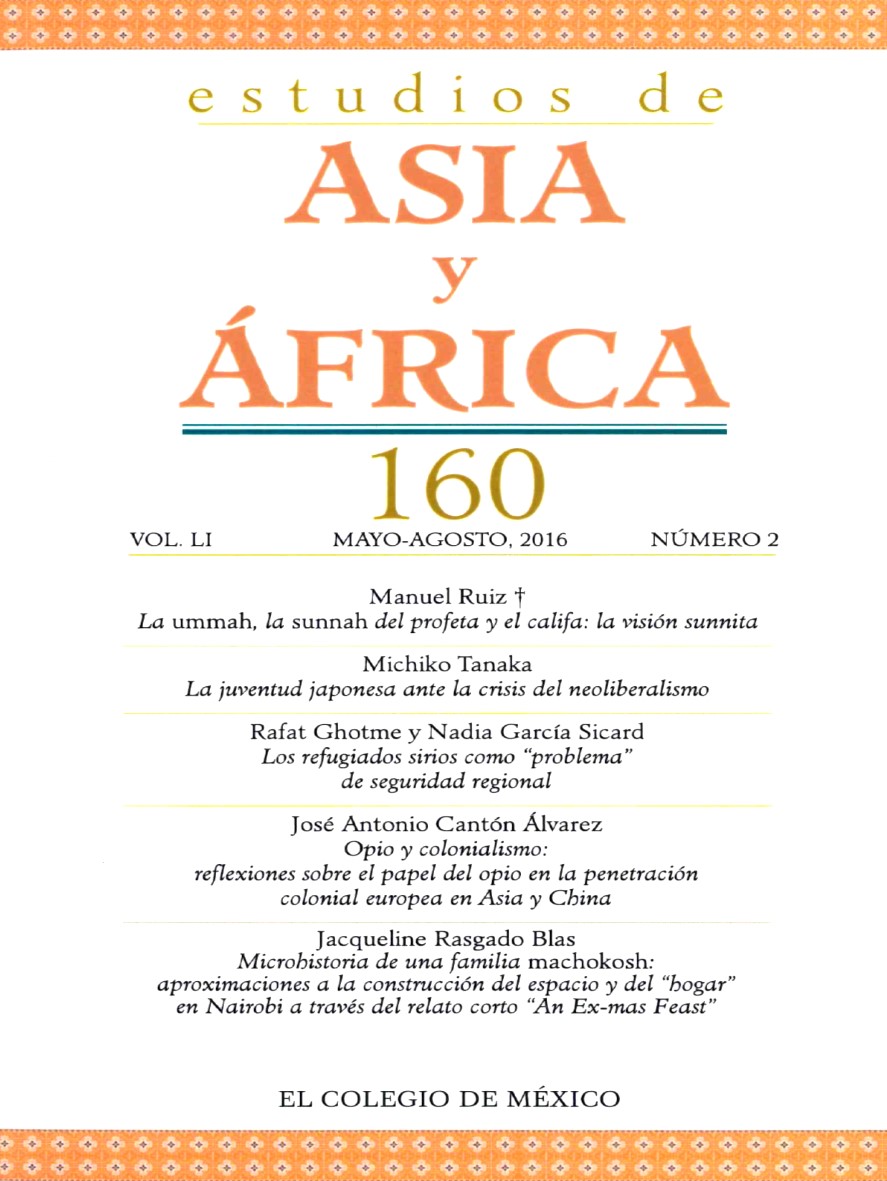Resumen
Este artículo explora la construcción del espacio y del “hogar” en el relato corto “An Ex-mas Feast”, el cual aparece en la colección de historias cortas Say You’re One of Them, del autor nigeriano Uwem Akpan, publicada en 2008, así como algunas representaciones de la ciudad de Nairobi en el género novelístico keniano que describen la vida en la ciudad entre las décadas de 1970 y 1990, analizadas críticamente por Roger Kurtz en su libro Urban Obsessions, Urban Fears: The Postcolonial Kenyan Novel.
Referencias
Agamben, Giorgio, Homo Sacer. Sovereign Power and Bare Life, trad. Daniel Heller-Roazen, Stanford, Stanford University Press, 1998.
Akpan, Uwem, Say You’re One of Them, Nueva York, Hachette Book Group, 2008.
Augé, Marc, Los no lugares: espacios del anonimato. Una antropología de la sobremodernidad, Barcelona, Gedisa, 2000.
Burgess, Thomas y Andrew Burton, “Introduction”, en Andrew Burton y Hélène Charton-Bigot (eds.), Generations Past: Youth in East African History, Atenas, Ohio University Press, 2010, pp. 1-24.
Burton, Andrew, African Underclass: Urbanisation, Crime and Colonial Order in Dar es Salaam, Londres-Atenas-Nairobi-OxfordDar es Salaam, British Institute in East Africa-Ohio University Press-British Institute in Eastern Africa-James Currey-Mkuki na Nyota, 2005.
Charton-Bigot, Hélène, “Preface”, en Hélène Charton-Bigot y Deyssi Rodriguez-Torres (eds.), Nairobi Today: The Paradox of a Fragmented City, Dar es Salaam, Mkuki na Nyota, 2006, pp. IX-XII.
Da Cruz, Fernando, Kerstin Sommer y Ombretta Tempra, Nairobi Urban Sector Profile, Nairobi, United Nations Human Settlements Programme, Nairobi, 2006. [asmarterplanet.com/ files/2012/09/UN-Habitat-Report-on-Nairobi.pdf, consultado el 30 de noviembre de 2012.]
Davies, Matthew, “A Childish Culture? Shared Understandings, Agency and Intervention: An Anthropological Study of Street Children in Northwest Kenya”, Childhood, vol. 15, núm. 3, 2008, pp. 309-330.
De Certeau, Michel, La invención de lo cotidiano I: las artes de hacer, trad. Alejandro Pescador, México, Universidad Iberoamericana, 2000.
Ferguson, James, Global Shadows: Africa in the Neoliberal World Order, Durham-Londres, Duke University Press, 2006.
Foucault, Michel, “Of Other Spaces”, Diacritics, vol. 16, núm. 1, 1986, pp. 22-27.
George, Rosemary Marangoly, The Politics of Home: Postcolonial Relocations and Twentieth-Century Fiction, Berkeley-Los Ángeles, University of California Press, 1999.
Githiora, Chege, “Sheng: Peer Language, Swahili Dialect or Emerging Creole?”, Journal of African Cultural Studies, vol. 15, núm. 2, 2002, pp. 159-181.
Hron, Madelaine, “Ora Na-Azu Nwa: The Figure of the Child in Third-Generation Nigerian Novels”, Research in African Literatures, vol. 39, núm. 2, 2008, pp. 27-48.
Illife, John, The African Poor: A History, Cambridge, Cambridge University Press, 1987.
Ivaska, Andrew, Cultured States: Youth, Gender and Modern Style in 1960s Dar es Salaam, Durham, Duke University Press, 2011.
Knapp, Adrian, “Three Children’s Critical Perspectives on Aspects of the Contemporary East African Social ‘Web of Relationships’: Uwem Akpan’s Say You’re One of Them”, Postcolonial Text, vol. 5 núm. 3, 2009, pp. 1-14.
Kurtz, John Roger, Urban Obsessions, Urban Fears: The Postcolonial Kenyan Novel, Trenton, Africa World Press, 1998.
Locatelli, Francesca y Paul Nugent (eds.), African Cities: Competing Claims on Urban Spaces, Leiden-Boston, Brill, 2009.
Lonsdale, John, “Town Life in Colonial Kenya”, en Hélène Charton-Bigot y Deyssi Rodriguez-Torres (eds.), Nairobi Today: The Paradox of a Fragmented City, Dar es Salaam, Mkuki na Nyota, 2006, pp. 1-22.
Lund, Christian, “Twilight Institutions: Public Authority and Local Politics in Africa”, Development and Change, vol. 37, núm. 4, 2006, pp. 685-705.
Margulis, Mario, “La ciudad y sus signos”, Estudios Sociológicos, vol. xx, núm. 3, 2002, pp. 515-536.
Médard, Claire, “City Planning in Nairobi: The Stakes, the People, the Sidetracking”, en Hélène Charton-Bigot y Deyssi RodriguezTorres (eds.), Nairobi Today: The Paradox of a Fragmented City, Dar es Salaam, Mkuki na Nyota, 2006, pp. 25-60.
Musangi, Jennifer Beatrice, A Walk Through The Criminal’s City: John Kiriamiti’s My Life in Crime and my Life in Prison, Johanesburgo, University of the Witwatersrand, 2008.
Mwangi, Meja, Kill Me Quick, Londres, Heinemann Educational, 1973.
Ngala, Joseph Adero, “Book Review of Say You’re One of Them”, African Proverbs, Sayings and Stories, s.f. [afriprov.org/index. php/book-reviews/447-say-youre-one-of-them.html, consultado el 3 de diciembre de 2012.]
Odhiambo, Tom, “Juvenile Delinquency and Violence in the Fiction of Three Kenyan Writers”, Tydskrif vir Letterkunde, vol. 44, núm. 2, 2007, pp. 134-148.
Odhiambo, Tom, “The City as a Marker of Modernity in Postcolonial Kenyan Popular Fiction”, Scrutiny2, vol. 10, núm. 2, 2005, pp. 46-56.
Ogude, James, Ngugi’s Novels and African History: Narrating the Nation, Londres, Pluto Press, 1999.
Owuor, Samuel y Teresa Mbatia, “Nairobi”, en Simon Bekker y Göran Therborn (eds.), Capital Cities in Africa: Power and Powerlessness, Ciudad del Cabo, HSRC Press, 2012, pp. 120-140.
Pratt, Mary Louise, Imperial Eyes: Travel Writing and Transculturation, Londres, Routledge, 1992.
Rodriguez-Torres, Deyssi, “Public Authorities and Urban Up grading Policies in Eastlands: The Example of ‘Mathare 4A Slum Upgrading Project’”, en Hélène Charton-Bigot y Deyssi Rodriguez-Torres (eds.), Nairobi Today: The Paradox of a Fragmented City, Dar es Salaam, Mkuki na Nyota, 2006, pp. 61-96.
Ross, Robert J. y Gerard J. Telkamp, Colonial Cities. Essays on Urbanism in a Colonial Context, Dordrecht, Martinus Nijhoff Publishers, 1985.
White, Luise, The Comforts of Home: Prostitution in Colonial Nairobi, Londres, University of Chicago Press, 1990.
Willis, Justin, “Budget Drinking: Alcohol Consumption in Two Kenyan Towns”, Journal of Eastern African Studies, vol. 3, núm. 1, 2009, pp. 55-73.
Esta obra está bajo una licencia internacional Creative Commons Atribución-NoComercial-SinDerivadas 4.0.
Derechos de autor 2022 Estudios de Asia y África


